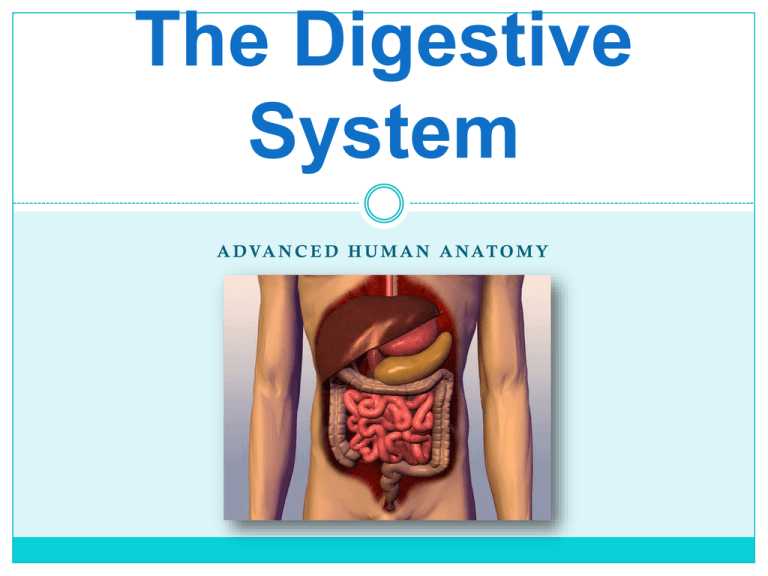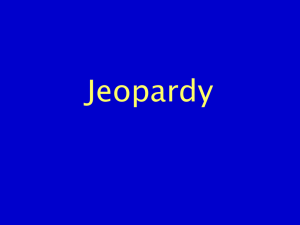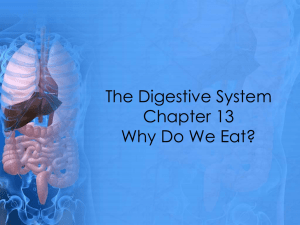The Digestive System
advertisement

The Digestive System A D VA N C E D H U M A N A N AT O M Y Introduction General function: physical /chemical breakdown of foodstuffs so it can be absorbed into the bloodstream and used by the cells/ tissues and eliminate nondigestible substances produced during metabolism Digestion: process of changing foodstuffs into usable substances Absorption: transfer of nutrients into the blood stream Digestive Processes Ingestion: process of taking food into the digestive tract Propulsion: process of moving food through the alimentary canal (swallowing, peristalsis) Mechanical digestion: physical preparation of food for chemical digestion; mastication, mixing of food with saliva by tongue, churning and mixing of food in stomach, segmentation in intestine Chemical digestion: catabolic process in which large food molecules are broken down into smaller molecules by enzymatic hydrolysis Absorption: transport of digested end products from the GI tract into the capillaries and lymph vessels Defecation: elimination of indigestible materials and waste from the body Alimentary Canal Gastrointestinal Tract (GI) Digests and absorbs food Coiled, hollow, muscular tube with 2 openings Approximately 30 feet long Includes: mouth, pharynx, esophagus, stomach, small intestine, large intestine Oral Cavity Mouth: root stoma = mouth Receives and tastes food Physical breakdown of food Partial digestion by saliva Lubrication of food Deglutition: the act of swallowing Hard palate: bony structure, roof of mouth, separates mouth from nasal cavity Pharynx/Esophogus Passageways 10 inches long; food only here 4-8 seconds; no chemical changes take place Pharynx: throat, tube that carries food and air Epiglottis: flap that covers the trachea when food or water is swallowed Esophagus: muscular tube dorsal to the trachea; carries food to the stomach by rhythmic wavelike motion Peristalsis: progressive wave-like smooth muscle contraction, distention Stomach Food stays 3-4 hours for physical and chemical breakdown Abdomen: stomach is located in the Left Upper Quadrant (LUQ) Peritoneum: membranes that line abdomen, decreases friction of organs (peritonitis) Mesentery: greater and lesser omentum forms protective covering that insulates organs and holds them in place Stomach (ctd.) Stomach Fundus, body, antrum Rugae: folds in stomach to increase surface area Sphincters: prevent reflux Cardiac- ring of muscle where esophagus and stomach join; keeps stomach contents from moving up into the esophagus Pyloric- ring like muscle between the stomach and small intestine; keeps food in stomach 30 minutes to 4 hours so that digestion can occur Gastric enzymes: pepsin (protein), rennin, lipase (fats), HCl (kills bacteria, helps in absorption of Fe, activates pepsin) Chyme: gastric juices plus digested food Small Intestine Approximately 21 feet long 1 inch in diameter 80% of absorption occurs here 3 sections Duodenum Jejunum Ileum Enzymes stimulate intestinal secretions Hormones inhibit intestinal secretions Peyer’s patches: lymph nodes in intestine to aid in defense/protection Duodenum 1st 10-12 inches Ducts from pancreas and gallbladder (sphincter of Oddi) enter here Receives chyme Pancreatic juices: amylopsin (sugars), trypsin (proteins), lipase (fats) Gallbladder: bile (emulsifies and breaks down fats) Intestinal juices: maltase/sucrase/lactase (breakdown sugars) Jejunum and Ileum Jejunum Middle portion; 8 feet partially responsible for absorbing nutrients into the bloodstream. It is lined with finger-like projections that are called villi, that move nutrients, vitamins and minerals from the intestine to the bloodstream Ileum Final 12 feet Connects to large intestine at cecum Process of digestion completed Absorbs bile acids, which are returned to the liver to be made into more bile, then stored in the gallbladder for future use in the duodenum. Absorbs vitamin B 12 , which the body uses to make nerve cells and red blood cells. The Digestive System A D VA N C E D H U M A N A N AT O M Y – DAY 2 Quick Review Ingestion, Propulsion, Digestion (mechanical and chemical), Absorption Mouth Pharynx Esophogus (Epiglottis helps direct traffic!) Stomach Duodenum Jejunum Ileum Peristalsis • Wavelike ripple of smooth muscle • Ring of contraction occurs where GI wall is stretched, pushing bolus forward • Stimulated by CCK – secreted by endocrine cells in presence of chyme Segmentation • Mixing movement • Forward and backward movement that mechanically breaks down food and mixes it with digestive juices Large Intestine Ileocecal valve: circular, sphincter muscle; prevents food from returning to ileum (small intestine) Cecum: pouch at first portion of the large intestines; lower end is the appendix Colon: absorbs water, remaining nutrients, electrolytes; storage of indigestible materials until elimination; transport waste out of the body Ascending (right side) Transverse Descending (left side) Sigmoid Rectum (final 6-8 inches): storage of feces Anal Canal Anal canal: anus; outlet of rectum Fecal matter: non-digestible waste products and bacteria Defecation: emptying of fecal matter from rectum 2 Sphincters Internal anal sphincter: involuntary, smooth muscle External anal sphincter: voluntary, skeletal muscle Accessory Organs Liver Largest gland/solid organ of body; Located in the RUQ under diaphragm; 3 pounds Secretes 1 liter of bile /24 hours Biliary tree: composed of hepatic duct, cystic duct, and common bile duct Functions Manufactures blood proteins (i.e. antibodies), blood clotting factors Stores iron, copper, vitamin A/D/B12, glycogen Produces bile for fat digestion Detoxifies blood Gallbladder Pear-shaped muscular sac under the liver Stores bile (approx. 500-600 ml. stored) Fatty foods enter duodenum stimulates CCK hormone contracts GB to release bile emulsifies fats and stimulates peristalsis of small intestine muscular tissue Bile pigments: bilirubin (formed from breakdown of RBCs) Bile helps soften stools, thus helping to speed up the movement of feces in the colon Bile helps destroy bacteria and other microbes that can be present in foods Obstruction of gallbladder icterus and jaundice Cholelithiasis: gallstones = cholesterol and bile salts Caused mainly by dietary choices Cholecystectomy: removal of GB Pancreas Behind the stomach; head attached to duodenum, tail reaching to spleen Exocrine functions: acini cells secrete digestive juices and bicarbonate ions (help adjust pH) Endocrine functions: carbohydrate metabolism Insulin and Glucagon: secreted from the islets of Langerhans for carbohydrate metabolism Diabetes: decreased secretion of insulin or insufficient insulin, therefore glucose is increased in blood Pancreatitis: inflammation caused by overproduction of pancreatic juices Appendix Function not fully known; but thought to provide safe place for good bacteria Appendicitis inflammation of appendix not common in elderly appendectomy – surgical removal of appendix Oral Cavity Accessory Organs Salivary Glands Saliva: lubricates food for swallowing; body produces 1500 ml in 24 hours Lubricates mouth during speech and chewing Moistens food for swallowing Contains enzyme (salivary amylase) which begins chemical breakdown of complex carbohydrates and starches into sugars Teeth 20 primary form 6 months to 2 years 32 permanent: incisors, canines, premolars/molars, cuspids/bicuspids Mastication: chewing Bolus: mass of chewed food Rumble in the Tummy? Stomach growling is the result of moving food through the stomach and into the small intestine. Pockets of air and gas also get squeezed into chyme and create the noises we hear. Stomach growling can happen at any time -- not just when you're hungry -- but if there's food in your stomach or small intestine, the growling becomes quieter. Hungry? Grab a Snickers. About two hours after your stomach empties itself, it begins to produce hormones that stimulate local nerves to send a message to the brain to prep for more food. The brain replies by signaling for the digestive muscles to restart the process of peristalsis. Two results occur: First, the contractions sweep up any remaining food that was missed the first time around. Second, the vibrations of an empty stomach make you hungry. Muscle contractions will come and go about every hour, generally lasting 10 to 20 minutes, until you eat again. Heartburn, GERD, Acid Reflux, Oh my! Heartburn is sometimes used interchangeably with acid reflux Mainly caused by acid splashing up and out of the stomach. Food is a key trigger to heartburn! Relaxation of esophageal sphincter or over production of stomach acid GERD is usually caused by changes in the barrier between the stomach and the esophagus Abnormal relaxation of the lower esophageal sphincter Impaired expulsion of gastric reflux from the esophagus Hiatal Hernia Crohn’s Disease Crohn’s disease belongs to a group of conditions known as Inflammatory Bowel Diseases (IBD). Crohn’s disease is a chronic inflammatory condition of the gastrointestinal tract. Crohn’s most commonly affects the end of the small bowel (the ileum) and the beginning of the colon Symptoms: persistent diarrhea, rectal bleeding, abdominal cramps and pain, sensation of incomplete evacuation, constipation (can lead to bowel obstruction) Colonoscopy Test that allows your doctor to look at the inner lining of your large intestine (rectum and colon) Uses a thin, flexible tube called a colonoscope to look at the colon Helps find ulcers, colon polyps, tumors, and areas of inflammation or bleeding Organ Mechanical Process Mouth (teeth and tongue) Mastication Deglutition Pharynx Esophagus Deglutition Deglutition Peristalsis Churning Peristalsis Segmentation Peristalsis Segmentation Peristalsis Mass peristalsis Defecation Stomach Small Intestine Ascending and Transverse Colon Descending Colon Rectum








